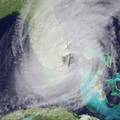 美國國家海洋暨大氣總署(NOAA)於艾西維爾市設立的國家氣候資料中心,其科學家根據初步的資料收集發現,全美今年的氣溫較往年高,並與至今的全球年平均溫相去不遠。而他們亦指出,若拿今年至11月的溫度來比較,2005年將是美國史上20個最熱的年度之一。
美國國家海洋暨大氣總署(NOAA)於艾西維爾市設立的國家氣候資料中心,其科學家根據初步的資料收集發現,全美今年的氣溫較往年高,並與至今的全球年平均溫相去不遠。而他們亦指出,若拿今年至11月的溫度來比較,2005年將是美國史上20個最熱的年度之一。
跨越2004-2005年的寒冬,對美國西部來說,充滿了不同的對比,在西南有傾盆大雨,而西北則出現嚴重的乾旱。接踵而來的太平洋冬季風暴引起加州南部嚴重豪雨和嚴重山崩,也帶來西南部地區有史以來第二潮濕的冬天。
西南部各地早春時期的雪量,也陸續破紀錄或是在破紀錄邊緣;大量降雪則緩和了該區持續五年的乾旱。
但是在太平洋沿岸的西北部和落磯山北部地區,2005年初的乾旱更形嚴重。此區大部分範圍內的積雪厚度,再冬季末期創下新低,然而接下來幾個月的降雪和降雨量卻又比往年平均值高,緩和了稍早的乾旱情形。
高於平均值的乾燥度,使得美國在2005年森林大火頻傳,共有8,500萬英畝面積被燒毀。
2005年的大西洋的颶風季則創下數項紀錄。26個有命名的颶風,其持續風力至少達每小時39英哩。而且還有14個前所未有的颶風,其中7個是超強颶風─在「薩非爾─辛普森颶風量級表」(Saffir-Simpson Scale)上歸為3級以上颶風。
2005年,大西洋出現3個等級5的強烈颶風,風速達每小時156英哩以上,分別是:卡崔納、莉塔和威爾瑪;並且這是首次三個5級颶風同時於同一季節內出現。
全球樣貌
2005年全球地表和海洋表面年均溫,相當接近1998年受到超級聖嬰現象影響所創下的全球均溫。2005年並沒有類似的聖嬰現象,不過全年全球大部分地區都異常溫暖。
NOAA現已開始採用改良式全球氣溫分析系統。根據NOAA過去8年來爲分析全球溫度所得的資料,2005年很可能成為紀錄上次暖的一年,比1880至2004年間的平均溫度高出攝氏0.59度,只比1998年稍低一些。
NOAA已整理了全美與世界各地的異常氣候紀錄,可參考:http://www.noaanews.noaa.gov/stories2005/s2548.htm
Temperatures across the United States this year were warmer than normal, and will come close to the all-time global annual average temperature, based on preliminary data gathered by scientists at NOAA's National Climatic Data Center in Asheville. NOAA scientists say that based on data from the first 11 months of the year, 2005 was one of the 20 warmest years on record in the United States.
The 2004-2005 winter was a season of contrasts for the West, with excessive rainfall in the Southwest and severe drought in the Northwest. A parade of winter Pacific storms triggered severe flooding and devastating landslides in southern California and brought the second-wettest winter on record to the Southwest region.
Record and near-record snowpack levels, which were widespread across the Southwest by early spring, eased drought in a region where it had persisted for five years.
But drought conditions worsened in the Pacific Northwest and northern Rockies in early 2005. Snowpack in much of the region was at record low levels at the end of winter, but above average snow and rain in the following months led to improving drought conditions in much of the region.
Drier-than-average conditions contributed to an active wildfire season that burned more than 8.5 million acres in 2005.
The 2005 Atlantic hurricane season set several records. There were 26 named storms with sustained winds of at least 39 miles per hour. In addition, there were an unprecedented 14 hurricanes, of which seven were major hurricanes - Category 3 or higher on the Saffir-Simpson Scale.
Three Category 5 storms with sustained winds of 156 miles per hour or more - Katrina, Rita, and Wilma - formed in the Atlantic Basin for the first time in a single season.
The Global Picture
The global annual temperature for combined land and ocean surfaces is expected to be very close to the record global temperature that was established in 1998 under the influence of an extremely strong El Niño episode. There has been no such El Niño event in 2005, but rather, unusual warmth across large parts of the globe throughout the year.
NOAA is in the process of transitioning to an improved global temperature analysis system. The data analysis system used by NOAA for global temperature analyses over the past eight years indicates that 2005 would likely be the second-warmest year on record – measuring 0.59 degrees Celsius above the 1880-2004 mean - just marginally lower than 1998.






